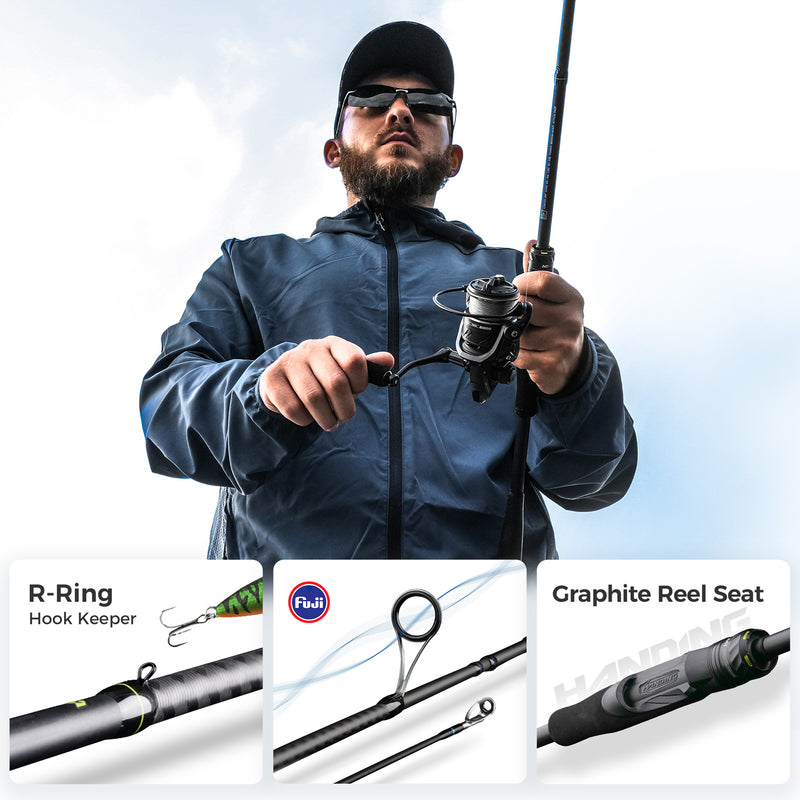Unlock the Secrets of Fishing Rods: Your Ultimate Guide to Choosing the Perfect Casting Companion!
Choosing the right fishing casting rod can make all the difference between a successful day on the water and a frustrating experience. With so many types available, it’s essential to understand the unique features and benefits of each rod to make an informed decision. Whether you’re a novice angler or a seasoned pro, this article will guide you through the various types of fishing casting rods, their specific characteristics, and tips on selecting the perfect one for your needs. Let’s dive deep into the world of fishing casting rods and discover how to enhance your fishing adventures!

Understanding Fishing Casting Rods
A fishing casting rod is a specialized tool designed for casting bait or lures to catch fish. Its primary function is to provide anglers with the flexibility and control needed to accurately place their line in the water. Generally, a casting rod consists of several key components: the rod blank, guides, reel seat, and handle. The rod blank is the main body of the rod, which is usually made from materials like graphite or fiberglass. Guides are the small rings that line the rod and help direct the fishing line, while the reel seat holds the fishing reel securely in place. Together, these components work harmoniously to enhance performance and improve the angler's experience on the water.
Types of Fishing Casting Rods
Fishing casting rods come in various types, each tailored for specific fishing techniques and scenarios. Here are some of the most common types:
1. Spinning Rods
Spinning rods are perhaps the most versatile and user-friendly type of casting rod. They are designed to work with spinning reels, which are mounted below the rod. These rods typically have a medium action, allowing for a good balance between casting distance and sensitivity. Spinning rods are ideal for beginners and are commonly used for light to medium fishing applications, making them suitable for freshwater species like bass and trout.
2. Baitcasting Rods
Baitcasting rods are designed for use with baitcasting reels, which are positioned on top of the rod. These rods offer greater control and accuracy, making them ideal for targeting larger species such as pike or muskie. Baitcasting rods usually have a stiffer construction, which allows for better hook-setting power. However, they require some skill to master, making them more suited for intermediate to advanced anglers.
3. Fly Rods
Fly rods are specially designed for fly fishing, a technique that requires casting lightweight flies using a weight-forward line. These rods are typically longer and more flexible than other types, allowing for graceful and precise casts. Fly rods come in various weights to match the size of the flies and the fish species targeted. They are perfect for fishing in rivers and streams, targeting species like trout and salmon.
4. Trolling Rods
Trolling rods are built for the specific purpose of trolling, which involves dragging bait or lures behind a moving boat. These rods are generally more robust, with a thicker blank to handle the stress of large fish. Trolling rods can be used in both freshwater and saltwater environments and are ideal for targeting larger species such as marlin, tuna, or walleye.
Key Features to Consider When Choosing a Casting Rod
When selecting a fishing casting rod, it’s essential to consider several key features that can significantly impact performance:
1. Length
The length of a fishing rod affects casting distance and accuracy. Longer rods generally allow for longer casts, making it easier to reach distant spots. However, they can be more challenging to handle in tight spaces. Conversely, shorter rods provide better control and are excellent for fishing in confined areas, such as small streams or dense cover.
2. Power and Action
Rod power refers to the rod's ability to lift and control fish, categorized as light, medium, or heavy. Action describes how much of the rod bends during casting. Fast action rods bend near the tip, while slow action rods bend throughout the length. Understanding these concepts is crucial for matching the rod to your fishing style and target species.
3. Material
Fishing casting rods are made from various materials, including graphite, fiberglass, and composite options. Graphite rods are lightweight and highly sensitive, making them ideal for detecting subtle bites. Fiberglass rods, while heavier, offer excellent durability and flexibility, making them a good choice for beginners. Composite rods combine the best features of both materials, providing a balance of sensitivity and strength.
4. Guides and Reel Seats
The quality of guides and reel seats can significantly affect rod performance. High-quality guides ensure smooth line movement, reducing friction during casting and retrieving. A sturdy reel seat is essential for securely holding your reel, ensuring that it remains stable during the fight with a fish. Investing in a rod with good guides and a reliable reel seat can enhance your overall fishing experience.
How to Choose the Right Fishing Casting Rod for Your Needs
Choosing the ideal fishing casting rod requires considering several factors, including your fishing style, target species, and experience level. Ask yourself the following questions: What type of fishing will you be doing (freshwater, saltwater, fly fishing)? What species do you want to target? Are you a beginner or an experienced angler? Your answers will guide you in selecting the right rod that complements your skills and meets your fishing objectives. Consulting with local fishing experts or experienced friends can also provide valuable insights into the best rod for your needs.
Summary of Key Takeaways
In this guide, we've explored the various types of fishing casting rods, their unique features, and the essential considerations for choosing the right one. Remember, selecting the perfect casting rod is crucial for enhancing your fishing experience, as it can significantly impact your success on the water. By considering your specific needs, fishing style, and preferences, you can find a casting rod that will become your trusted companion on many fishing adventures to come. Happy fishing!








